The Nike streaker, clad only in scarf and shoes with the swoosh, starts across the soccer field when -- surprise -- out of nowhere comes a brawny football player with a red Reebok jersey who tackles the streaker and knocks him to the ground.
This commercial -- a parody of Nike's successful streaker commercial featuring Reebok's own "Terry Tate, Office Linebacker" character -- rates as a "gotcha" for Reebok, the one-time sneaker king that spent the 1990s watching Nike's dust.
Now Reebok says it is roaring back, led by Paul Fireman, the 58-year-old CEO who transformed the company from an obscure English custom shoe business to the biggest athletic shoe company in America by 1987 -- about the same time he was kicked upstairs and replaced by C. Joseph LaBonte, a Harvard business graduate and former head of the 20th-Century Film Corp.
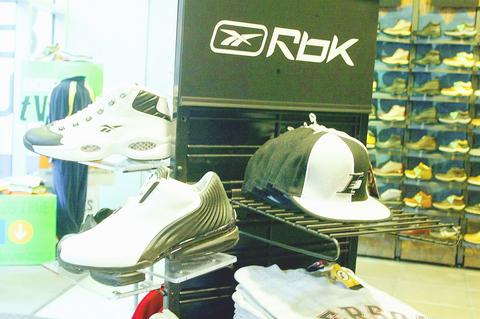
PHOTO: NY TIMES
"There is a certain wish for vindication," Fireman, who never graduated from college, conceded in a recent interview.
Reebok, along with the other athletic shoe companies, still trail Nike: Sporting goods intelligence, a trade newsletter, estimated that, at the end of last year, Nike had 39.1 percent of the nation's athletic shoe business; Reebok had 12; New Balance had 11.6; and Adidas had 9.6 percent.
But analysts say Reebok has a good chance to at least double its share in the next few years. Since Fireman regained day-to-day control in November 1999, the Canton, Massachusetts, company has increased sales, increased cash and increased exposure.
In the fourth quarter of 2002, Reebok's total sales increased a better-than-expected 14.8 percent, to US$763 million. Clothing sales in the US grew 48.1 percent, to US$145 million. According to a Lehman Brothers report on Feb. 5, Reebok has had 11 consecutive quarters of sales increases.
"We are the No. 2 company in America," Fireman said. But ranking, he said, is not his priority.
"Right now, I'm not sure I want to surpass Nike's volume -- we did that once," Fireman said.
"As much as I want to be the No. 1 aspirational brand, we're on a good path now and if this escalates into a competition between Nike and ourselves and Adidas, then I'm happy with that, too."
Right now, Reebok is rushing to fill the empty shelves in the US' more than 2,500 Foot Lockers after Nike and Foot Locker, the world's largest athletic footwear chain, had a falling out.
In February 2002, Foot Locker told Nike the store wanted to reduce the number of Nike's marquee shoes, because it believed consumers were turning more to the mid-priced shoes.
According to a person close to the deal, Foot Locker told Nike it wanted to reduce its marquee shoes from 12 percent of the chain's business to 6 percent, and canceled US$150 million in Nike orders.
Nike struck back. Nike denied that it had pulled back on existing orders or punished Foot Locker with late shipments, as had been reported.
"But Foot Locker will no longer be a primary distribution for marquee and launch products," said Charles Denson, the president of Nike Brand, in a December call with analysts.
On Feb. 15, Nike's "Hall of Hoops" displays in the nation's Foot Locker stores were replaced by Reebok's "Above the Rim," featuring RBK shoes and jerseys and hats endorsed by Allen Iverson, the Philadelphia 76er star. Reebok has also filled the vacuum with more of its Classic line, part of the retro look that has been successful for such sneaker also-rans as Converse and Puma.
"They jumped on the retro trend, with sneakers like those sold 10 to 20 years ago -- the youth of today haven't seen them," said Matthew D. Serra, the chief executive of Foot Locker. "Retro is very hot, and Reeboks are very affordable: US$60, US$70 for most of them. We put them in, and the customers responded."
Because of the new business at Foot Locker, several analysts this week gave Reebok a good chance to increase its current 12 percent market share closer to 20 percent in the next few years.
"Obviously, the Nike-Foot Locker dispute opened the door," said John Horan, publisher of Sporting Goods Intelligence, an industry newsletter. "Both Reebok and Adidas are both going for 20 percent in the US."
Although he said he disdained rankings, Fireman has no problem with aspiring to 20 percent.
"I view this as a renaissance, a complete regrouping, a complete rebirth," Fireman said.
Fireman brought Reebok to America in 1979; in 1981, he took an English partner, Pentland Industry, run by Stephen Ruben, who got 56 percent of the common stock in exchange for US$77,500 in cash and US$300,000 in letters of credit, Fireman said.
Under his guidance, Reebok became an `980s phenomenon. In 1983, sales were US$12 million; by 1987, they were US$1.3 billion.
"It really exploded," he said. "In 1982, we introduced women's aerobic shoes -- we had running shoes up until then. In 1983, we reinvented the tennis shoe -- lightweight, cushioned, it didn't wear out." The company went public in 1985. When sales reached US$307 million, in 1991, the English partner was bought out.
Then the pendulum swung from fitness and individual sports to team sports. "Michael Jordan was famous by 1988, a basketball icon," Fireman said. "But Reebok had trouble making the transition into sports."
In 1987, the Reebok board decided it was time to let somebody else run the company and Fireman was elevated to the new position of chairman, with no responsibility for the day-to-day running of Reebok.
"All those young people, who would have climbed mountains for me, walked off a cliff for me," he said, trying not to sound bitter. "And all of us were replaced by people who were part of the package goods mentality."
Although sales continued to grow, Fireman contends the business ran out of gas, "all the emotions were gone."
Fireman came back as chief executive in November 1999, just as the stock price was approaching its nadir of around US$7. It closed at US$30.80 on Wednesday.
"The first year, we struggled to regain purpose," he said. "The second year, to retain integrity of the brand and the third year -- the question is how do we get into the game of winning, of moving to the top? We fixed the basics, built our self-esteem and built market share."
The company is now moving on multiple fronts: Besides Iverson, whom Reebok signed up six years ago, and a roster of younger basketball stars like Steve Francis of the Houston Rockets, the company has a deal with the rapper Jay-Z (although it balked at paying Kobe Bryant for an endorsement deal worth between US$4 and US$5 million). The marketing budget is now US$40 million, up 38 percent from the previous year.
In December 2000, Reebok signed a licensing contract with the NFL.
Nike still has merchandising deals with nine teams out of 26 NBA teams this year; by November 2004, it will have none. All the teams will be signed with Reebok.
But Reebok is still looking for a logo that rivals that of Nike.
"We've got this vector cross on every NFL jersey, a little square with a slant," Fireman said.
"We need our own swoosh. We need a recognizable symbol, something that gives the kid at the gym an emotional attachment."
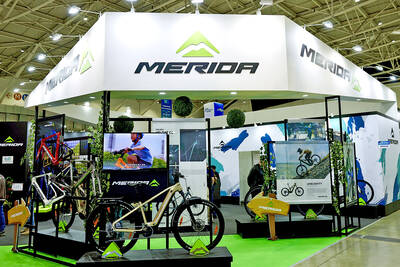
Merida Industry Co (美利達) has seen signs of recovery in the US and European markets this year, as customers are gradually depleting their inventories, the bicycle maker told shareholders yesterday. Given robust growth in new orders at its Taiwanese factory, coupled with its subsidiaries’ improving performance, Merida said it remains confident about the bicycle market’s prospects and expects steady growth in its core business this year. CAUTION ON CHINA However, the company must handle the Chinese market with great caution, as sales of road bikes there have declined significantly, affecting its revenue and profitability, Merida said in a statement, adding that it would
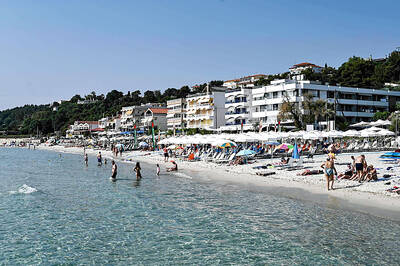
Greek tourism student Katerina quit within a month of starting work at a five-star hotel in Halkidiki, one of the country’s top destinations, because she said conditions were so dire. Beyond the bad pay, the 22-year-old said that her working and living conditions were “miserable and unacceptable.” Millions holiday in Greece every year, but its vital tourism industry is finding it harder and harder to recruit Greeks to look after them. “I was asked to work in any department of the hotel where there was a need, from service to cleaning,” said Katerina, a tourism and marketing student, who would
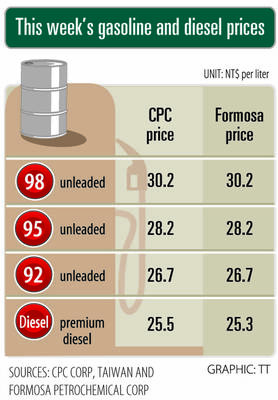
i Gasoline and diesel prices at fuel stations are this week to rise NT$0.1 per liter, as tensions in the Middle East pushed crude oil prices higher last week, CPC Corp, Taiwan (台灣中油) and Formosa Petrochemical Corp (台塑石化) said yesterday. International crude oil prices last week rose for the third consecutive week due to an escalating conflict between Israel and Iran, as the market is concerned that the situation in the Middle East might affect crude oil supply, CPC and Formosa said in separate statements. Front-month Brent crude oil futures — the international oil benchmark — rose 3.75 percent to settle at US$77.01
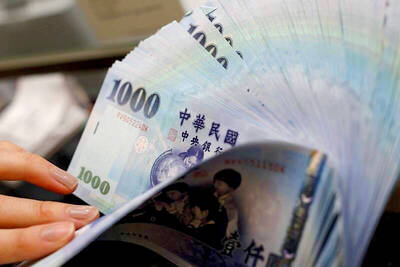
RISING: Strong exports, and life insurance companies’ efforts to manage currency risks indicates the NT dollar would eventually pass the 29 level, an expert said The New Taiwan dollar yesterday rallied to its strongest in three years amid inflows to the nation’s stock market and broad-based weakness in the US dollar. Exporter sales of the US currency and a repatriation of funds from local asset managers also played a role, said two traders, who asked not to be identified as they were not authorized to speak publicly. State-owned banks were seen buying the greenback yesterday, but only at a moderate scale, the traders said. The local currency gained 0.77 percent, outperforming almost all of its Asian peers, to close at NT$29.165 per US dollar in Taipei trading yesterday. The